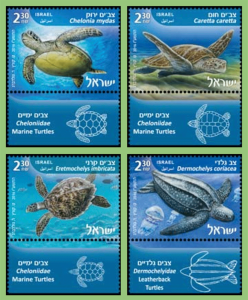 Marine Turtles are the largest reptiles in Israel. They live mostly in the sea, but the females come ashore on summer nights to lay dozens of eggs in cavities they dig in the sand. The offspring hatch in about two months.
Marine Turtles are the largest reptiles in Israel. They live mostly in the sea, but the females come ashore on summer nights to lay dozens of eggs in cavities they dig in the sand. The offspring hatch in about two months.
In some turtle species, the offspring’s gender is determined by the temperature in the nest. In the 1920’s and 1930’s sea turtle populations suffered greatly, with some 2000 green turtles being hunted each year along Israel’s coast. Despite that, in the 1950’s 15 nests per kilometer were reported on Israel’s northern beaches. The fact that in 2011 only one nest per kilometer was found on average in those areas highlights the sharp decline in the marine turtle populations, despite conservation efforts and legal protections.
Marine Turtles are endangered for various reasons: adults are injured by ship propellers, by ingesting waste and plastic bags, by fishing nets and hooks; nests are harmed by vehicles driving on the beaches, by human activity on the beaches at night and by animal predators; reduced numbers of beach sites available for nesting and artificial lighting along the beaches deters females from laying their eggs, as well as causing the offspring to lose their innate sense of direction, which guides them to the sea upon hatching.
Israel Nature and Parks Authority rangers and volunteers operate a national center that rescues and rehabilitates injured marine turtles. They also work to protect nests and when necessary, transfer eggs to protected incubation farms. The general public assists the Authority by reporting sightings of egg laying and injured turtles. (For urgent reports regarding injured turtles call: *6911).
Hawksbill Turtle Eretmochelys imbricate
The Hawksbill Turtle is the smallest of the marine turtles and is considered to be the most beautiful, thanks to the brown, black and yellow scutes tiled on its shell. This species is endangered mainly due to hunting in Southeast Asia. The turtle’s narrow head allows it to extract prey from among the coral. The Hawksbill Turtle occasionally frequents the Gulf of Eilat. The background of the stamp features the seabed and sea creatures typical to the Gulf of Eilat. The stamp tab features a schematic sketch of the Hawksbill Turtle’s scutes and scales, and clearly shows its narrow head.
Green Turtle Chelonia mydas
The Green Turtle is the only marine turtle that is mainly herbivorous in adulthood. Only 15 nests on average belonging to this species are found along Israel’s beaches. However, 63 of the 192 turtles, dead or injured, that wash onto the shore on average each year are Green Turtles.
The stamp features the underbelly of the Green Turtle, with the surface of the sea as seen from underwater shown in the background. The stamp tab features the scutes and scales of the Green Turtle’s back shell.
Loggerhead Turtle Caretta caretta
The Loggerhead Turtle is the most prevalent marine turtle in the Mediterranean Sea and it lays the largest numbers of eggs along Israel’s beaches (some 135 nests per year in recent years). It is mostly carnivorous, eating jellyfish, fish and crabs.
The stamp features the Loggerhead Turtle near the sandy seabed, with barnacles clearly shown attached to its shell. The stamp tab features the unique scutes and scales pattern that differentiates this species from the Green Turtle, clearly showing the fifth scute in rows along the sides.
Leatherback Turtle Dermochelys coriacea
The Leatherback Turtle is the largest and heaviest turtle species in the world, measuring up to 3 meters in length and weighing up to 930 kgs. As opposed to other marine turtles, its shell is covered with hard skin rather than scutes. The Leatherback Turtle migrates great distances across the oceans, swims faster than all other marine turtles (up to 35 km/h) and can dive to a depth of 1280 meters. This species feeds mainly on jellyfish and only rarely appears along Israel’s shores, in the Mediterranean Sea and the Gulf of Eilat. The background of the stamp features jellyfish, which are the Leatherback Turtle’s main food source. The ridges on the turtle’s back are prominent. The stamp tab highlights this species’ hydrodynamic body.
—Prof. Amos Bouskila
Ben-Gurion University of the Negev
Description of the First Day Cover
A marine turtle hatching from an egg is in the foreground.
A newly hatched turtle making its way toward the sea, leaving typical tracks in the sand, is featured in the background.




Ƅookmarked!!, ӏ reaⅼly ⅼike your blog!